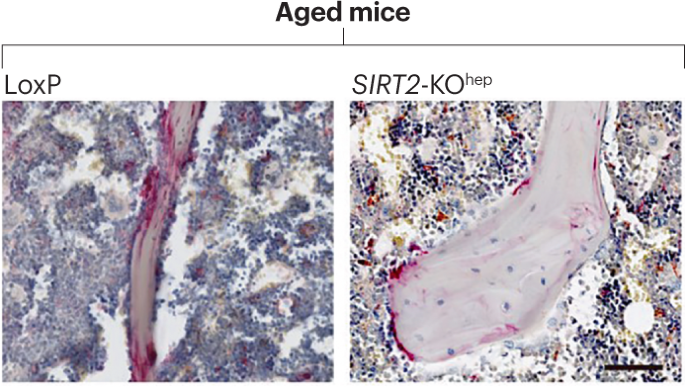
Liver–bone crosstalk implicated in osteoporosis progression
- Select a language for the TTS:
- UK English Female
- UK English Male
- US English Female
- US English Male
- Australian Female
- Australian Male
- Language selected: (auto detect) - EN
Play all audios:
Access through your institution Buy or subscribe Osteoporosis is a disease characterized by a low level of bone formation (by osteoblasts) and an excess of bone resorption (by osteoclasts),
in part due to increased differentiation of osteoclasts from their precursor cells, bone marrow-derived monocytes (BMDMs). A new study finds that deficiency in the deacetylase SIRT2 in
hepatocytes reduces bone loss in mouse models of osteoporosis. They then generated a liver-specific knockout of SIRT2 (_SIRT2_-KOhep mice). Aged _SIRT2_-KOhep mice had statistically
significantly higher bone mass than age-matched controls. Additionally, _SIRT2_-KOhep mice had lower serum levels of C-terminal telopeptide for type 1 collagen, a marker of bone turnover,
and lower numbers of osteoclasts than controls. The researchers then co-cultured BMDMs in vitro with plasma from either _SIRT2_-KOhep mice or control mice; the culture was treated with the
cytokines M-CSF and RANKL to induce osteoclast differentiation. Plasma from _SIRT2_-KOhep mice suppressed RANKL-induced osteoclastogenesis, as shown by the reduced number and size of
osteoclasts and reduced expression of key markers of osteoclastogenesis compared with the control co-cultures. This is a preview of subscription content, access via your institution ACCESS
OPTIONS Access through your institution Access Nature and 54 other Nature Portfolio journals Get Nature+, our best-value online-access subscription $32.99 / 30 days cancel any time Learn
more Subscribe to this journal Receive 12 print issues and online access $209.00 per year only $17.42 per issue Learn more Buy this article * Purchase on SpringerLink * Instant access to
full article PDF Buy now Prices may be subject to local taxes which are calculated during checkout ADDITIONAL ACCESS OPTIONS: * Log in * Learn about institutional subscriptions * Read our
FAQs * Contact customer support REFERENCES ORIGINAL ARTICLE * Lin, L. et al. SIRT2 regulates extracellular vesicle-mediated liver–bone communication. _Nat. Metab._
https://doi.org/10.1038/s42255-023-00803-0 (2023) Article PubMed PubMed Central Google Scholar Download references AUTHOR INFORMATION AUTHORS AND AFFILIATIONS * Nature Reviews
Endocrinology http://www.nature.com/nrendo/ Olivia Tysoe Authors * Olivia Tysoe View author publications You can also search for this author inPubMed Google Scholar CORRESPONDING AUTHOR
Correspondence to Olivia Tysoe. RIGHTS AND PERMISSIONS Reprints and permissions ABOUT THIS ARTICLE CITE THIS ARTICLE Tysoe, O. Liver–bone crosstalk implicated in osteoporosis progression.
_Nat Rev Endocrinol_ 19, 440 (2023). https://doi.org/10.1038/s41574-023-00859-8 Download citation * Published: 31 May 2023 * Issue Date: August 2023 * DOI:
https://doi.org/10.1038/s41574-023-00859-8 SHARE THIS ARTICLE Anyone you share the following link with will be able to read this content: Get shareable link Sorry, a shareable link is not
currently available for this article. Copy to clipboard Provided by the Springer Nature SharedIt content-sharing initiative